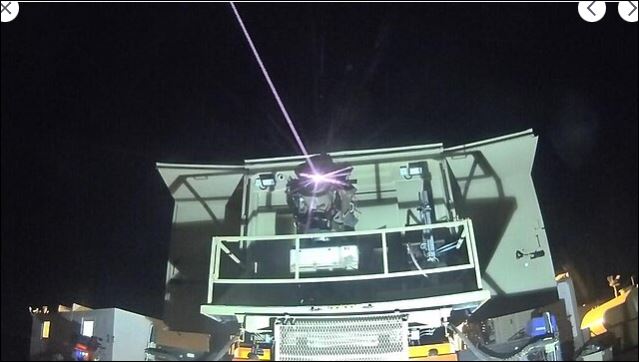
by Rafael Advanced Defense Systems photographer
Creative Commons Attribution-Share Alike 3.0
Israel’s Iron Beam (also known as Magen Or or “Light Shield” in Hebrew) is a directed-energy weapon system developed primarily by Rafael Advanced Defense Systems, in collaboration with Elbit Systems and, for the U.S. market, Lockheed Martin. Unveiled in 2014 at the Singapore Airshow, it represents a significant evolution in air defense technology, building on earlier joint U.S.-Israel projects like the Tactical High Energy Laser (THEL), which was canceled in 2005 due to bulkiness and high costs. Funded mainly by the Israeli Ministry of Defense (MoD), Iron Beam uses a high-power fiber laser—typically rated at 100-150 kW—to generate a focused beam that heats and destroys incoming threats by burning through them in seconds, without physical projectiles.
The system is designed as a cost-effective complement to Israel’s multi-layered missile defense architecture, including Iron Dome (for short-range rockets), David’s Sling (medium-range), and Arrow (long-range ballistic missiles). It targets short-range threats such as rockets, artillery shells, mortars, and unmanned aerial vehicles (UAVs or drones), with an engagement range of a few hundred meters to several kilometers (up to 7-10 km in initial versions, with extensions in development). Key advantages include near-zero marginal cost per interception (estimated at $2-3.50, mainly electricity), unlimited “ammunition” as long as power is available, minimal collateral damage, and rapid response times. However, limitations include reduced effectiveness in adverse weather (e.g., fog, heavy clouds, or dust storms that scatter the beam) and the need for line-of-sight to maintain focus on the target for 4-5 seconds.
Iron Beam integrates with existing radar systems like those in Iron Dome, allowing automated decisions on whether to use a laser or missile based on threat type and conditions. Variants include the mobile Iron Beam-M (50 kW for maneuverable forces), Lite Beam (10 kW, vehicle-mounted for shorter ranges), Naval Iron Beam (for sea platforms), and the newer Iron Beam 450 (enhanced range and speed). As of 2024, the system had undergone successful tests against simulated threats, with full operational maturity achieved through accelerated development during ongoing conflicts.
### Recent News Concerning the System (as of September 2025)
Iron Beam has seen rapid progress amid escalating regional threats from groups like Hamas, Hezbollah, and the Houthis. In May 2025, Rafael announced the world’s first combat use of high-power laser systems—described as prototypes or scaled-down variants (e.g., Lite Beam or Iron Beam-M)—to intercept over 40 Hezbollah drones during the Gaza War in October 2024. Videos released showed the lasers burning through drone wings, causing crashes without explosion. The Israeli MoD clarified these were not the full Iron Beam but complementary directed-energy platforms, marking a historic milestone as the first operational laser intercepts in combat.
By March 2025, Defense Minister Israel Katz visited Rafael facilities and confirmed the system would become operational within nine months, emphasizing its role in countering rocket and drone swarms at a fraction of Iron Dome’s $40,000-$50,000 per missile cost. In September 2025, the MoD and Rafael declared Iron Beam fully operational after weeks of advanced tests in southern Israel, successfully intercepting rockets, mortars, drones, and aircraft in diverse scenarios. Delivery to the Israel Defense Forces (IDF) is slated for late 2025, with initial deployment enhancing the Air Force’s Aerial Defense Array. Officials hailed it as positioning Israel as the first nation with mature high-power laser defense capabilities.
At the DSEI 2025 defense exhibition in London (September 9), Rafael showcased mockups of Iron Beam variants, including the Iron Beam 450, highlighting single-digit dollar costs per shot and applications for land, sea, and mobile units. The system has also benefited from U.S. support, with $1.2 billion allocated in 2024 for procurement (distinct from earlier R&D funding). Ongoing developments include airborne laser variants by Elbit for hypersonic threats and maritime adaptations. Despite protests at DSEI over Israel’s Gaza operations, the focus remains on Iron Beam’s “game-changing” potential for layered defense.
Data Source: Grok 3 AI
